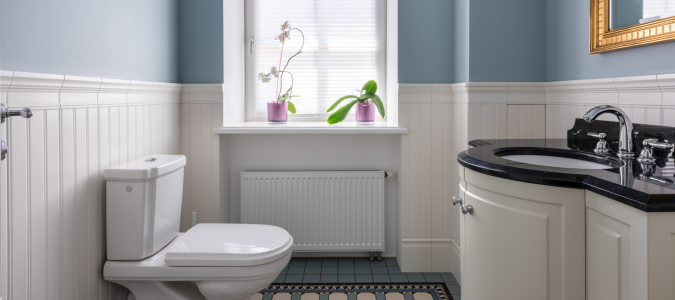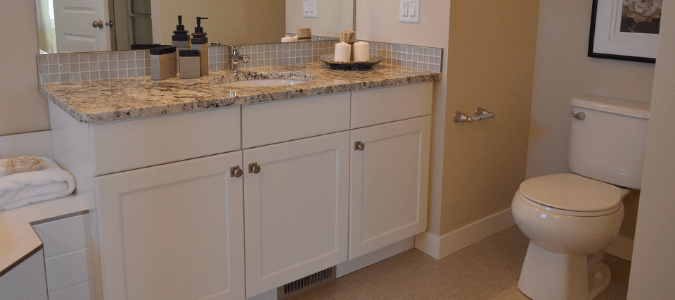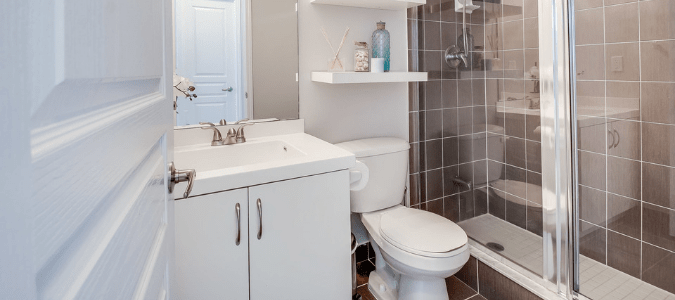If you notice that your toilet is making sounds like gurgling and whining, it can be annoying as well as wasteful. If your toilet makes all kinds of gurgling and whining noises, you probably have the flapper to blame for that. It’s a small piece of rubber or plastic hiding in the murky depths of the toilet tank. If it’s not sealing well, it can cause problems for your toilet.
Fortunately for homeowners, flapper issues are usually easy to fix. Here are some troubleshooting methods you can try. But if none work, you can let a professional plumber come to the rescue. They’ll get to the bottom of things and provide the best solution.
What to Do If Your Toilet Flapper Is Not Sealing
The toilet flapper might not be visible, but it plays a crucial role in the toilet system. It seals off the opening below the toilet tank, preventing water from flowing into the bowl. When you flush, the flapper lifts to let the water rush out. As the water level in the tank drops, the flapper will drop back down and close the valve.
You’ll know the flapper isn’t sealing well if your toilet runs continuously. It could mean the flapper is broken or worn out. The fill valve will then keep supplying the tank with water to try and refill it. Don’t let this issue go unaddressed because it can lead to higher water bills.
Before you can fix this problem, you need to know where the flapper is. When you remove the toilet tank’s lid and look inside, you’ll see a flap valve with a hinge at the bottom. There’s a chain that attaches it to the flush handle lever. It is typically black or red. Once you’ve located it, you can either clean or replace it.
Cleaning the Toilet Flapper
A common reason for a leaking flapper is gunk buildup. A toilet flapper can’t provide a tight seal if dirt and debris are all over it. You can wipe it with an old rag or use a mineral-removing liquid to give it a more thorough cleanse. Follow the manufacturer’s instructions closely if you’re doing the latter.
Replacing the Toilet Flapper
If the flapper is cracked, warped or brittle, it’s beyond cleaning and requires replacement. Here’s how a professional will install a new one:
- First, they will start off by rotating the shut-off valve clockwise to turn off the toilet’s water supply. They will find it on the water supply line. Next, they’ll empty the tank by holding down the flush. That will make it easier for them to access the flapper.
- Next, a plumber will detach the flapper chain from the flush handle lever. This lever extends from the flush handle and hovers over the flapper. They will unhook it and allow the chain to drop. Next, they’ll shift the flapper’s ears off the flush valve tube’s pegs and remove the old flapper.
- Then, they will attach the new flapper’s ears onto the flush valve’s pegs. They will start by connecting the new chain to the flush handle lever. The chain should be a little loose when the lever is in its resting position. If it’s too tight, the flapper won’t be able to close all the way. But there shouldn’t be too much slack, either. If the chain is too long, it can get caught under the flapper. A plumber will adjust the chain’s length as needed.
- Finally, they will rotate the shut-off valve counterclockwise to turn the water supply back on. They’ll make sure to test that the new flapper and chain are working by flushing the toilet a few times and making sure the flapper goes up and down.
Toilet repairs can be annoying and difficult. If toilet repairs aren’t your thing, contact a professional plumber. You’ll have a new flapper in no time.
How to Adjust the Toilet Flapper
Knowing how to adjust the toilet flapper is a helpful skill for homeowners. There are two scenarios where it will come in handy.
The first is if your toilet doesn’t flush unless you keep pressing the flush handle. That probably means the flapper isn’t lifting enough from the flush valve. The second is if the toilet won’t stop running after flushing. That usually means the flapper isn’t aligned with the flush valve and can’t create a watertight seal. Whichever the scenario, it’s important to adjust the toilet flapper.
Fixing a Toilet That Will Not Completely Flush
If you’re experiencing this issue with your toilet, that means the flapper chain has too much slack. Because it’s too loose, it can’t lift the flapper high enough to let the correct volume of water rush into the bowl. You must adjust the chain’s length to prevent the flapper from closing prematurely. Here’s how to do it:
- Locate the flapper chain. It’s hanging from the flush handle lever and connected to the flapper at the bottom. You can shorten its length by moving the clip to a lower chain link. Squeeze the clip shut to secure it. There should only be half of an inch of slack.
- Test your work. If the toilet still isn’t flushing all the way, you might have to shorten the chain a bit more.
- After you’ve found the correct chain length, it’s time to cut the excess chain links. If you leave them hanging, they might get caught in other parts and cause more problems. You can use cutting pliers to remove them.
While these repairs are somewhat simple, it’s often more than a homeowner wants to work on their toilet. Leave this repair to a professional plumber.
Fixing a Toilet That Will Not Stop Running
If water keeps flowing into the bowl even after flushing, the toilet flapper is not sealing tightly enough. Because water keeps emptying from the tank, the fill valve will keep trying to refill it. It’s a never-ending cycle that wastes water and money. Follow these steps to resolve this issue:
- Check that the flapper chain isn’t too long. If it is, the chain probably gets stuck between the flapper and the flush valve, preventing the needed watertight seal. Shorten the chain by following the steps above.
- If there’s no problem with the flapper chain length, there might be a misalignment between the flapper and flush valve. You can correct the flapper’s position by adjusting the guide arm adjustment screw. Use slip joint pliers to loosen it, then move it around until the flapper sits directly on the flush valve. Retighten the screw.
- If you see that the flapper is old and worn out, no amount of readjusting will fix the issue. It’s time to replace it.
Toilet issues can be intimidating, especially to homeowners with no DIY experience. Contact a professional plumber if you don’t want to tackle toilet flapper problems. They have the tools and expertise to resolve whatever trouble you’re experiencing and will have your toilet running smoothly again.
What to Do When the Toilet Tank Is Losing Water but There Is No Leak
If your toilet’s tank loses water constantly, you most likely have a leak. The question is, is it external or internal? If you see water on the bathroom floor or the walls around the toilet, it’s the former. But if there are none, it’s likely the latter.
You can confirm your toilet is internally leaking by doing a simple leak test. Drop a colored toilet tablet or some food coloring into the tank, ensuring it’s full of water. Leave the toilet as is and return in about 10 to 15 minutes. Peek into the bowl and see if the water in it is colored. If it is, the toilet tank leaks into the bowl and requires immediate attention.
Flapper issues are the most common culprit behind internal toilet leaks. If the flapper can’t form a tight seal around the flush valve, the water will empty from the tank into the bowl. That happens when the flapper is dirty, misaligned or too old to function.
You have a couple of options if the flapper is giving you problems. First, you can deep clean it so it can provide a better seal. You can also try adjusting it until it sits securely on the flush valve. But there’s nothing much you can do if it’s falling apart. In that case, it’s time for a replacement. With a professional plumber’s help, you’ll have a new flapper in no time.
Leave Your Toilet Troubles to a Professional
All homeowners are bound to experience toilet troubles at some point. The flapper, in particular, is known for causing annoying toilet problems. But that doesn’t mean you have to listen to your toilet run all day. There are many ways to troubleshoot flapper issues and restore peace in your bathroom. However, it’s easiest to contact a professional plumber about any problems you are having with your toilet.
ABC Can Help With Your Toilet Problems
When dealing with plumbing problems, it’s not worth making a mess yourself. Instead of trying to learn the ins and outs of plumbing, contact ABC Home & Commercial Services. Our licensed professionals can efficiently diagnose and repair any plumbing issue you may have. In cases where a repair isn’t possible, we can help you decide which type of toilet works best for you and then install it.



